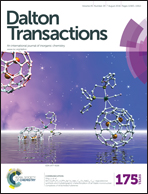Theoretical studies on the bonding and electron structures of a [Au3Sb6]3− complex and its oligomers
Abstract
Recently an all-metal aromatic sandwich compound of a [Sb3Au3Sb3]3− ion has been synthesized and characterized experimentally, which indicates that there might exist a variety of stable all-metal sandwich complexes. The intralayer and interlayer chemical bonding interaction in this system plays significant roles in their stability, chemical properties and functionalities. Here we report a systematic theoretical study on the geometries, electronic structures, and chemical bonding of the [Sb3Au3Sb3]3− ion and its congeners of [X3Au3X3]3− (X = N, P, As, Sb, Bi, Uup) as well as [X3M3X3]3− (M, X = Cu, As; Ag, Bi; Au, Sb; Rg, Uup) to understand the special stabilities of these species. Additional studies are also performed on the oligomers [Sb3(Au3Sb3)n]3− (n = 1–4) to explore whether the sandwich compound can form stable extended systems. Through extensive theoretical analyses, we have shown that among the [Au3X6]3− (X = N, P, As, Sb, Bi, Uup) species, [Sb3Au3Sb3]3− is most stable due to superb matching of Sb3 and Au3 in both geometric size and fragment orbital energies. The significant stability of the [Au3Sb6]3− ion is determined by the interlayer (p-d-p)σ interactions between the vertical Au 5d6s hybrid orbitals of Au3 and Sb 5pπ orbitals of the Sb3 rings. Each Sb3 ring demonstrates unique σ aromaticity, which remains when the complex is extended to oligomers. The results suggest that it is likely that there might exist other stable [ApMpAp]x− (M = transition metals, A = main group elements, p = 3, 4, 5, …) sandwich ions and oligomers.
![Graphical abstract: Theoretical studies on the bonding and electron structures of a [Au3Sb6]3− complex and its oligomers](/en/Image/Get?imageInfo.ImageType=GA&imageInfo.ImageIdentifier.ManuscriptID=C6DT00602G&imageInfo.ImageIdentifier.Year=2016)

 Please wait while we load your content...
Please wait while we load your content...